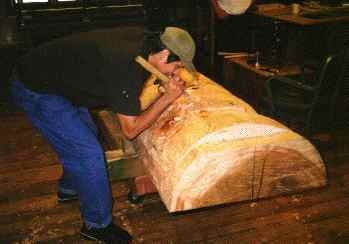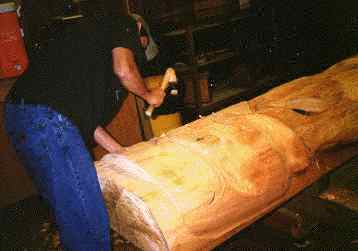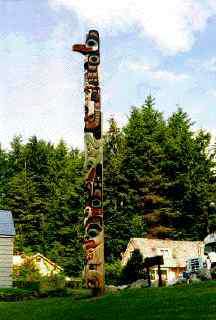From SOCIETY OF INTERNATIONAL FRIENDSHIP NEWSLETTER 39, Winter 1994/95
The native ethnic groups of the Pacific Northwest had a very class-conscious
society. Therefore, as was mentioned in part one, totem poles were
one of the ways in which people showed their status, both by the amount
of money they were able to spend on having a pole carved, and by the
symbols or crests-usually animals-which they could claim as their
own and display on their totem pole.
Edward Malin writes that property and ownership rights were very
important in the Northwest Coast culture. This included rights to
the crests and stories depicted on poles. It was a crime to claim
those stories or crests that were owned by someone else. These symbols
defined a person's family lineage or clan membership.
Usually one's right to a certain crest was based on whatever family
or clan they were born into, but there were other ways in which people
came to own certain crests. It may have been passed on as part of
a dowry from a rich family when their daughter married. The crest
may have been claimed as payment to set right a wrongdoing, or as
the spoils of victory after a raid on another tribe. Therefore, when
a person wanted to erect a totem pole, they had to be careful that
their pole would not appear to infringe on someone else's property,
as did the man hired to carve the totem pole.
The Carver
Carvers held an important role in those areas where poles were carved.
Malin writes:
Carvers were highly respected and well-paid craftsmen. They were
unusually gifted, for in addition to their carving skills they
were composers of songs, mask makers for the traditional theatrical
dramas, dancers, and orators for ceremonial occasions. Carvers
were among the most culturally perceptive members of the society,
being not only well traveled as a result of their varied commissions
but also being privy to the tribal histories and lore of the leading
families of several neighboring tribes.
 He goes on to note that men became carvers by going through a rigorous apprenticeship
with established wood craftsmen, and that carvers had to be men with
connections and respected lineages. Until recently, women were never
carvers, he writes, "despite the fact that women were held in
high regard in Northwest Coast culture."
He goes on to note that men became carvers by going through a rigorous apprenticeship
with established wood craftsmen, and that carvers had to be men with
connections and respected lineages. Until recently, women were never
carvers, he writes, "despite the fact that women were held in
high regard in Northwest Coast culture."
When a carver was hired to make a pole, his first task was to gain
a thorough knowledge of his patron's family history and the meaning
of the crests which the family owned. Malin emphasizes that the carver
would not begin carving until he had spent hours and hours listening
to his patron describe these legends, gaining an understanding of
every nuance of every story.
While the wood carvers worked in many different types of wood, only
one type of wood was good enough for totem poles: red cedar. Red cedar
breaks predictably, and is soft and easy to carve, but when it dries
it becomes hard and resists moisture well. Malin writes that the wood
can survive outdoors for 50 years or more.
Malin and Holder are in distinct disagreement about how trees were
chosen to be carved into totem poles. Malin writes that procuring
a tree was the responsibility of the carver's patron, who undertook
the search with his family members, and that the choice was based
on scientific considerations. For example, trees found deep in the
rain forest, where light was limited, had fewer knots and would resist
rot better. Holder, however, gives the impression that magical elements
were involved, and that carvers were involved in the search. "To
help in locating the best tree," he writes, "a Haida carver...would
douse his hands with magic 'medicine', a mixture of water and berries,
and place a yew-tree branch in his mouth. Having performed this ceremony,
the carver, it was thought, could walk straight to the best tree."
The two authors agree, of course, that transporting the tree to the
village was a difficult undertaking. It was preferable to find a tree
located near the water, so that it could be floated back to the village.
Malin writes that the fallen tree's limbs would first be removed,
then it would be placed on log rollers to move it to the river.
The entire project of planning and carving the pole, Malin writes,
could take two years or more. During this time, the carver and his
family would be financially supported by the patron, including living
in the patron's household. This was only part of the carver's payment;
he would also receive financial reimbursement after the project was
complete.
According to Holder, carving was done in the solitude of a heavily
wooded area, in order to "lend mystery and excitement to the
pole-raising ceremony that was to come." Malin, however, writes
that poles were carved on beaches, presumably after having been floated
there from where the tree had been cut down. While Malin's story sounds
more logical, it's also possible that the two authors are writing
of the customs of different pole-carving tribes.
 As noted in my previous article, iron-bladed tools were introduced into
the Pacific Northwest about 200 years ago, greatly improving the quality
of the poles being carved. Carvers also used bone, shell, stone, and
copper tools. The primary carving tool is referred to by Malin as
an elbow adze, a long-handled tool with a blade jutting out from it
(as shown in the photo at left). A variety of other tools were used
to smooth, pound, and cut; carvers also often painted their poles.
As noted in my previous article, iron-bladed tools were introduced into
the Pacific Northwest about 200 years ago, greatly improving the quality
of the poles being carved. Carvers also used bone, shell, stone, and
copper tools. The primary carving tool is referred to by Malin as
an elbow adze, a long-handled tool with a blade jutting out from it
(as shown in the photo at left). A variety of other tools were used
to smooth, pound, and cut; carvers also often painted their poles.
While some writers, including Holder, have minimized the role of
the carver in terms of creativity, Malin asserts that the totem pole
carver, while he had no control of the subject matter of his work,
had free reign to interpret his patron's myths and crests as he wished.
"The carver was not a mere copier, his path and perceptions rigidly
controlled by someone else," Malin states. The carver's challenge,
he goes on, was to "establish new insights and interpretations"
of the standard crest symbols without straying too far from the traditional
portrayals of them.
The Potlatch
After the pole was finished, it was raised at a special gathering
called a potlatch. Potlatches, which could last for several days,
might be attended by hundreds of people, who would be served lavish
meals and participate in or observe whatever ceremonies were to be
performed.
While the word "potlatch" may appear to be a fusion of
two English words, the American Heritage Dictionary
traces it to the Nootka word "patshtl", meaning "gift".
Holder seems to see the central purpose of the potlatch as being the
raising of a totem pole, but Malin indicates that this was not the
case. Potlatches were held for centuries before the Northwest peoples
began carving totem poles, and they were held by inland groups who
never carved poles.
Furthermore, Malin sees potlatching as being primarily a social function.
Families, clans, or whole tribes competed against each other to see
who could hold the best potlatch. There were region-wide rankings
of which groups had held the most successful potlatches to date. Success
was measured in the amount of wealth given away by the hosts, in the
form of food and gifts, to those who attended. Hosts were to surrender
all their accumulated wealth to outsiders, as a way of expressing
pride in the ownership of their crests and other property. Sometimes
potlatches were held in order to defend the host's honor against the
taunts of others, who were subsequently obliged to keep quiet.
While potlatches were held in order to show the extent of the group's
material possessions, this was done by giving them all away. However,
the prestigious social standing earned by the giving of a successful
potlatch was the most important thing, and the more wealth that was
given away, the higher the prestige. Obviously, this could lead the
group in question to financial ruin.
Raising a pole
While the raising of a pole may not have been the main purpose of
a potlatch, it could certainly enhance the prestige associated with
one. Furthermore, it would have been unthinkable to raise a pole without
having a potlatch; Malin notes that "a pole raised without a
potlatch would lack meaning and significance."
The pole was brought to the potlatch site on log rollers before the
event. A hole of about 6 to 8 feet in depth (1.8 to 2.4m) had been
dug for the pole, with a slanted trench leading up to it. The pole,
therefore, would already be tilted somewhat towards the hole as it
lay in the trench. Another piece of wood had been placed in the hole
to help steady the totem pole somewhat after it had fallen into the
hole. Cedar bark rope had been tied around the pole and run over a
scaffold, which was about 20 feet (60m) high.
The people assembled to raise the pole would receive shouts of encouragement
from the host or a specially designated orator, writes Malin. They
would be asked to show teamwork, diligence, and caution in the raising
of the pole. This was a great moment for the family, Malin notes,
because it had taken years to prepare for it. It would be a great
day for the family--unless the raising of the pole were to result
in its falling due to a broken rope or other mishap. A fallen pole
would be such a disaster, says Malin, that it "might necessitate
hosting an even greater potlatch to erase the memory from the minds
of the guests."
The pole would be pulled from the front, with direction and support
from others underneath the pole who steered it with ropes and supported
it with notched sticks. As the pole raisers worked, the orator would
continue to encourage them, and visiting dignitaries would make speeches.
As the pole fell safely into the hole, the smaller piece of wood
was removed. When the column had been faced toward the sea, earth
and large rocks were quickly put into the hole around the pole.
The moment when the pole became completely vertical was an emotional
one, Malin writes: "Few people walked away unaffected by the
experience." This was followed by hours of explanations of the
legends represented on the new pole. The storytelling sessions had
intermissions, during which guests received more food and gifts.
Malin notes that the pole he chose to draw in illustrating the raising
of a totem pole is "historically important":
It is drawn from a copy of an original Tlingit pole belonging
to the Hunt family of Tongass village, Alaska. The copy was raised
in 1905 in Fort Rupert, a Kwakiutl village. The potlatch celebrating
its raising was impressive. The ceremony and pole were designed
to proclaim the family's prominent northern origins, implicitly
challenging those who had called their origins into question.
It was raised by David Hunt to honor his great-grandmother, the
daughter of a renowned Tlingit chief, and was known as the Hunt
"Raven" pole. The carver was Charlie James, a Kwakiutl.
Malin goes on to say that the pole rotted and fell to the ground
in the mid-1950s, and was then cut into several pieces and eventually
sent to the Glenbow Museum in Calgary, Alberta.
Sources
Holder, Glenn Talking Totem Poles, 1973, Dodd, Mead
& Company, New York.
Malin, Edward Totem Poles of the Pacific Northwest Coast,
1986, Timber Press, Portland, Oregon




 This page last updated
November 4, 2002
. E-mail Tim
This page last updated
November 4, 2002
. E-mail Tim